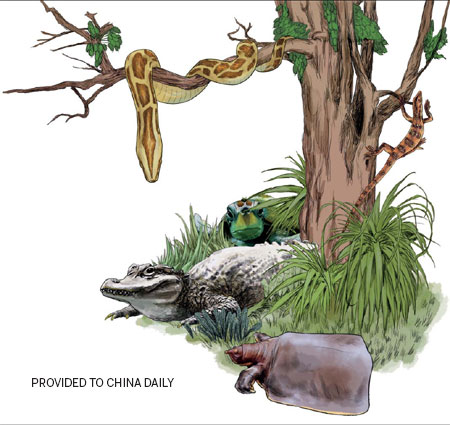

China's 5 largest reptiles are more delicate than you might think 中国最大的五种爬行动物
While dragons are the stuff of imagination, China boasts tangible - and substantial - reptiles that can both chill the blood and tug the heartstrings of empathetic animal lovers. Reptiles come in many forms in China, including grand survivors and niche monsters. From one of the only species of alligator in the world to turtles from antiquity, China has a rich diversity of reptilian giants trying to eke out an existence in the modern world. However, with habitats disappearing, prey dying off or just ending up in a local diner, the size of these animals is largely a curse. Many of these often critically endangered beasts are under threat of becoming just as mythical as their legendary cousin, the dragon. Spine-chilling snakes and leviathan lizards may seem scary, but they are far more important to a delicate ecosystem than, say, a web designer. However, while there are only a few hundred Chinese alligators - for some reason - web designers abound. Tragically, there were many animals that could have been included in this list but no longer exist, such as the Yangtze soft-shelled turtle.
Five-Fingered Golden Dragon
五爪金龙 (Wǔ zhǎo jīn lóng)
Size: 1.5-2 meters
Weight: 20-50 kilograms
Food: Crabs, birds, snakes, small mammals, carrion
Location: Southeast Asia, South China, Hong Kong
More commonly known in English as the water monitor (水巨蜥 (shuǐjùxī), these animals are endemic to many countries, including China, and thanks to their extraordinary ability to adapt and eat just about anything - living or dead - they exist in strong numbers and in a variety of habitats in Southeast Asia. Though it's arguably the smallest on the list, the average adult weighs about 20 kg. It can be found in burrows, swimming, on land and even in trees. That's bad luck for people who can't see the beauty in this scaly survivor and would rather run; it's even worse luck that it can likely outrun them with its powerful legs. This comes in handy because, when hunting, the water monitors tend to chase prey rather than ambush them, like most reptiles. While not necessarily dangerous to humans, these animals do have a reputation of having a nasty temper, hissing, opening their mouths and flicking their tongues as a threat. With their amazing adaptability, they are among the most common large lizards in Asia. This malleability means they are in no danger of going extinct any time soon, but the story in China is somewhat more harrowing. The China Species Red List (《中国物种红色名录》 zhōngguó wùzhǒng hóngsè mínglù) claims this creature is critically endangered in China, on the brink of extinction in the wild.
Yangtze Alligator
扬子鳄 (Yángzǐ'è)
Size: 1.5-2 meters
Weight: 35-40 kg
Food: Snails, mussels, fish, others
Location: Zhejiang, Anhui and Jiangsu provinces
As one of only two species of large alligator in the world and the only large crocodilian native to China, this armored reptile is perhaps less well-known (and smaller) than its North American cousin, but it is nonetheless fascinating and the closest thing China has to a modern dragon. It is the only crocodilian to hibernate, and, unlike those in Florida, the Chinese alligator is completely armored, including its underbelly. Its relatively small size prevents it from being a danger to humans despite its fierce reputation in the West. However, judging from the character鼍龙 (tuó lóng), this alligator was mentioned in the famous Journey to the West as the rebellious nephew of the Dragon King of the West Sea; he disguises himself as a boatman to sink the ship and eat the pig and the monk, but is thwarted by the Monkey King. Perhaps the most interesting mention is in a saucy tale in In Search of the Supernatural (《搜神记》 sōushén jì) from the 4th century when a man invites a panicked, sexy woman onto his boat for bawdy thrills; the next morning he wakes up to discover the woman he slept with was actually the spirit of a Yangtze alligator. Unfortunately, all of this biological wonderment and mythological acclaim hasn't helped the animals' survival. It is quite possibly the single most endangered large crocodilian in the world due to habitat degradation and hunting. Appearing on the International Union Conservation Nature's Red List as "critically endangered" (one step from "extinct in the wild"), this species is in big trouble. More than 10,000 of these alligators live at the Anhui Research Center for Chinese Alligator Reproduction near Xuancheng. The disturbing news is that many of them are raised for their meat, largely due to there not being enough natural habitat left. Current estimates are at 100 to 200 in the wild.
Asian Giant Soft-shelled Turtle
鼋 (Yuán)
Size: 1.3-2 meters
Weight: 50 kg
Food: Crustaceans, mollusks, fish
Location: Southeast Asia, India, East and South China
This is often called Cantor's Giant Soft-shelled Turtle, but long before it was discovered by Western science, it was well known in China. In Journey to the West the protagonists were carried across a river on its back, and legend has it that a general in the Warring States Period (475BC-221BC) used alligators and these turtles to build a bridge to march his armies across. The reptile's strange appearance is due to the fact that this 50 kg monster spends most of its life just beneath the surface of a thin layer of mud. Even though it doesn't look like much, this creature has a secret talent for catching prey: a lethal strike, an extremely fast attack that can snatch the reptile's fast-moving prey. However, this marvel is often a victim itself, often from poachers looking for a slow, easy target. Beyond its legendary good taste, a traditional belief has it that consuming this particular freshwater turtle can make you strong. Once, long ago, Chinese people kept these strange looking animals as pets in their gardens, but now they are so rare that even catching a glimpse of one is newsworthy.
Burmese Python
缅甸蟒 (Miǎndiàn mǎng)
Size: 4 meters
Weight: 90 kg
Food: Birds, small mammals, deer
Despite what the name might suggest, these reptiles are endemic to South China and are likely the python of many Chinese legends. Often caricatured as a voracious beast, Chinese myth doesn't think too highly of these particular snakes. In one myth, a python named Bashe (巴蛇) swallowed elephants whole, a myth that inspired the phrase巴蛇吞象 (bā shé tūn xiàng) which literally means "snake gulping down an elephant", an idiom used to describe insatiable greed. Much like the water monitor, these snakes are survivors, becoming an invasive species in areas such as North America. But despite the myth surrounding these modern dragons, even exceptionally large pythons are afraid of humans. However, these monsters have deadly potential, meaning - as if you needed to be told - it's important not to manhandle or mistreat them. Of course, there are those who keep these animals as pets.
Green Sea Turtle
绿海龟 (Lǜhǎiguī)
Size: 1-1.5 meters
Weight: 135-190 kg
Food: Sea grass
Sea turtles are sacred to many as gentle giants and weary travelers. In China, they are perhaps best known for their ability to travel. In fact, the popular term haigui 海归 refers to Chinese students who study abroad and still decide to return home. While these beautiful animals call many countries in the world home, there is only one nesting site left for these travelers in China - in Guangdong province at the National Huidong Sea Turtle Reserve. The numbers there are classified by the reserve authorities for some unknown reason. The green fat underneath the turtle's shell (its namesake) was considered a delicacy in ancient China, and people from Hawaii to the Bahamas have been using this animal for its skin, meat and eggs for hundreds - even thousands - of years. The toll has been the making of an endangered species. Today, they are in danger of boat strikes, poachers and the complete destruction of their precious nesting areas. Unlike the Chinese students to which they are compared, these peaceful colossi often don't have homes to return to.
Courtesy of The World of Chinese,
www.theworldofchinese.com
The World of Chinese
(China Daily Africa Weekly 07/19/2013 page27)








